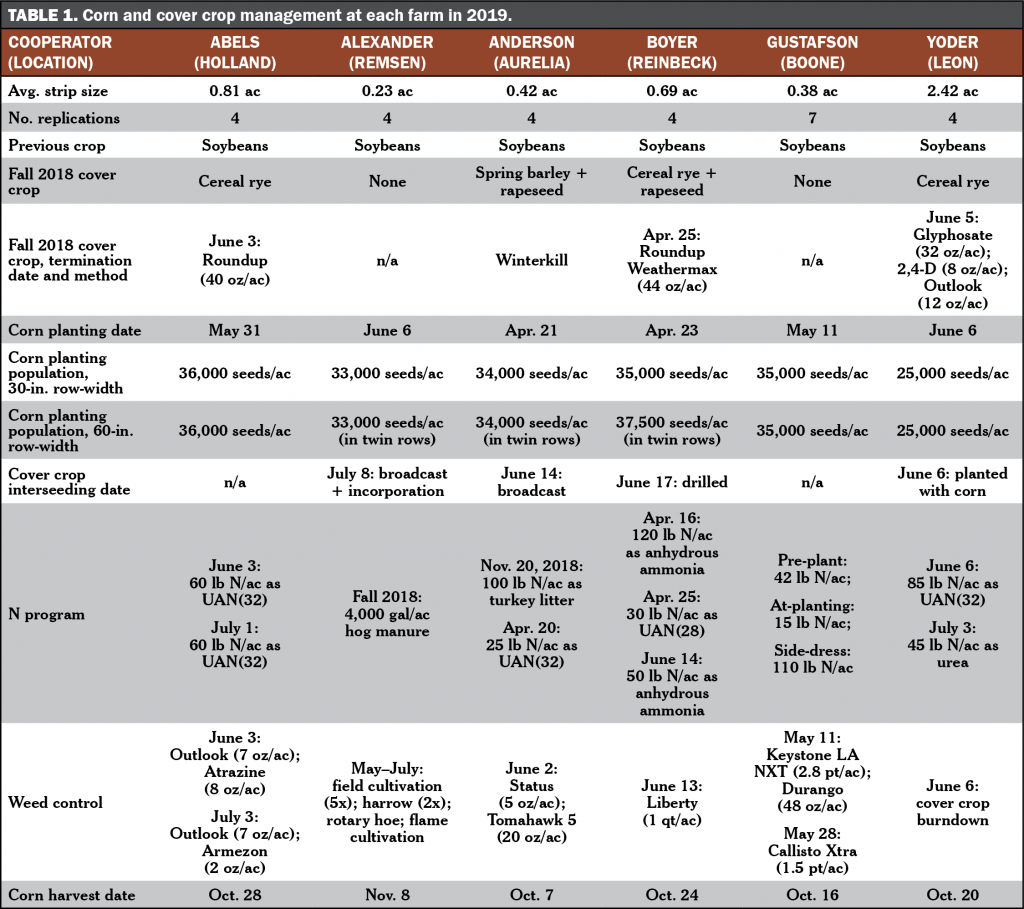This project was funded by USDA-NRCS and the Walton Family Foundation.
In a Nutshell
- This was the second year of on-farm research trials designed to evaluate planting corn in 60-in. row-widths for the purpose of improving the success of interseeding cover crops to the corn in early summer, while maintaining corn grain yield.
- Fred Abels, Robert Alexander, Nathan Anderson, Jack Boyer, Jeremy Gustafson and Mark Yoder planted corn in two row-widths (30- and 60-in.) and compared interseeded cover crop biomass production and corn yields between the two row-widths.
Key Findings
- Cover crops interseeded to corn in 60-in. row-widths produced five to 25 times as much biomass as cover crops interseeded to corn in 30-in. row-widths.
- Compared to 30-in. row-widths, corn planted in 60-in. row-widths produced lower yields at four of the six farms.
Background
This report describes the second year of on-farm research trials that investigated the effects of widening the corn row-width and interseeding cover crops. Widening the corn row is a version of the solar corridor crop system concept which “is designed for improved crop productivity based on highly efficient use of solar radiation by integrating row crops with drilled or solid seeded crops in broad strips (corridors) that also facilitate establishment of cover crops for year-round soil cover.”[1] In 2018, two farms saw no difference in corn yields between the 30- and 60-in. row-widths, while two other farms saw yields reduced by 6–30% in the 60-in. row-widths compared to the 30-in. row-width.[2] These mixed results were in accord with previous research from the University of Missouri that found equivalent corn yields between 30- and 60-in. row-widths in one year and yields reduced by 14–39% in the 60-in. row-widths in two other years.[3] On average, the 60-in. row-width resulted in five times as much cover crop biomass as the 30-in. row-width across the farms in 2018.[2] The opportunity to grow as much as 4,000 lb/ac of cover crop biomass by the time of corn harvest with 60-in.-wide corn rows is particularly appealing to those wishing to graze livestock in the fall. And all the more so if corn grain yields match those expected with 30-in. row-widths.
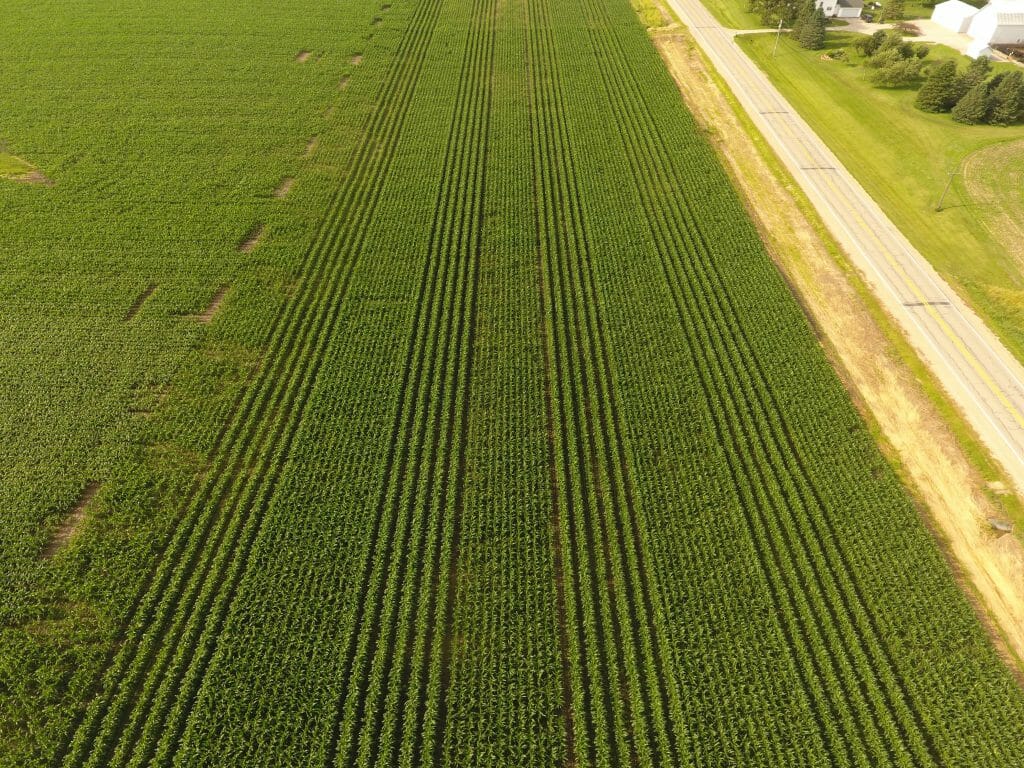
Strips of corn planted in 30- and 60-in. row-widths at Jack Boyer’s on July 1, 2019. Corn was planted on Apr. 23 and cover crops were interseeded to corn on June 17.
“I’m looking for ways to increase cover crop diversity and improve cover crop survival and growth [when interseeding to corn in June] without sacrificing corn yield,” said Jack Boyer, who also conducted the trial in 2018. Nathan Anderson cited his interest in increasing the feed value of cover crops for fall grazing and increasing the overall diversity on his family’s farm as his motivation for conducting the trial. Likewise, Fred Abels, Robert Alexander and Mark Yoder each indicated that the potential to add more grazing days to row-crop fields would have major impacts on their farms.
Methods
Design
Each cooperator planted randomized and replicated strips of corn in 30- and 60-in. row-widths and then interseeded cover crops to all strips in early summer (Figure A1), except Abels and Gustafson who were both unable to interseed. Alexander’s farm is under organic management while all other farms are conventional. Strips at each farm were as wide as at least one combine pass and ran the length of the field. Corn and cover crop management at all farms is provided in Table 1.
Alexander, Anderson, Boyer and Yoder independently chose a cover crop to interseed:
- Alexander: buckwheat (5 lb/ac); cereal rye (10 lb/ac); collards (2 lb/ac); cowpeas (7 lb/ac); crimson clover (3 lb/ac); phacelia (1 lb/ac); rapeseed (2 lb/ac); winter peas (7 lb/ac).
- Anderson: annual ryegrass (8 lb/ac); buckwheat (5 lb/ac); common vetch (4 lb/ac); crimson clover (4 lb/ac); flax (5 lb/ac); rapeseed (1 lb/ac).
- Boyer: buckwheat (6 lb/ac); cereal rye (30 lb/ac); collards (2 lb/ac); cowpeas (3 lb/ac); crimson clover (3 lb/ac); phacelia (2 lb/ac); rapeseed (1 lb/ac).
- Yoder: cowpeas (25,000 seeds/ac).
Measurements
All cooperators who interseeded cover crops assessed aboveground cover crop biomass near corn harvest by clipping shoot and leaf material from quadrats randomly placed in each strip. We sent biomass samples to Midwest Laboratories (Omaha, NE) to determine dry weight and N concentration.
All cooperators harvested corn individually from each strip. Yoder harvested corn for earlage. All other farms harvested corn grain and grain yields were corrected to 15.5% moisture.
Data analysis
To evaluate any effects of corn row-width, we calculated the least significant difference (LSD) using a t-test for each measurement: cover crop biomass, cover crop N content and corn yield. For each measurement, if the difference resulting from the two row-widths was greater than or equal to the LSD, we considered this a statistically significant effect. On the other hand, if the difference resulting from the two row-widths was less than the LSD, we considered the row-widths to be statistically similar. We used a 95% confidence level to calculate the LSDs, which means that we would expect our findings to occur 95 times out of 100. We could make these statistical calculations because the cooperators’ experimental designs involved replication of the two corn row-widths (Figure A1).
Results and Discussion
Cover crop biomass
At three of the four farms that collected samples, the farmers observed more cover crop biomass where corn was planted in 60-in. row-widths compared to the 30-in. row-widths (Table 2). These findings were particularly relevant to Abels, Alexander, Anderson and Yoder, who each cited livestock grazing of cover crops as a motivation for conducting these experiments. We also sent samples from three of the farms to Midwest Laboratories to determine the N content of the cover crop biomass. The cover crops interseeded to corn in 60-in. row-widths contained between five and 25 times as much N as the cover crops interseeded to corn in 30-in. row-widths (Table 2). Cover crop N can contribute to N pools of soil organic matter; monitoring potential benefits to succeeding crops in the rotation probably warrants investigation.
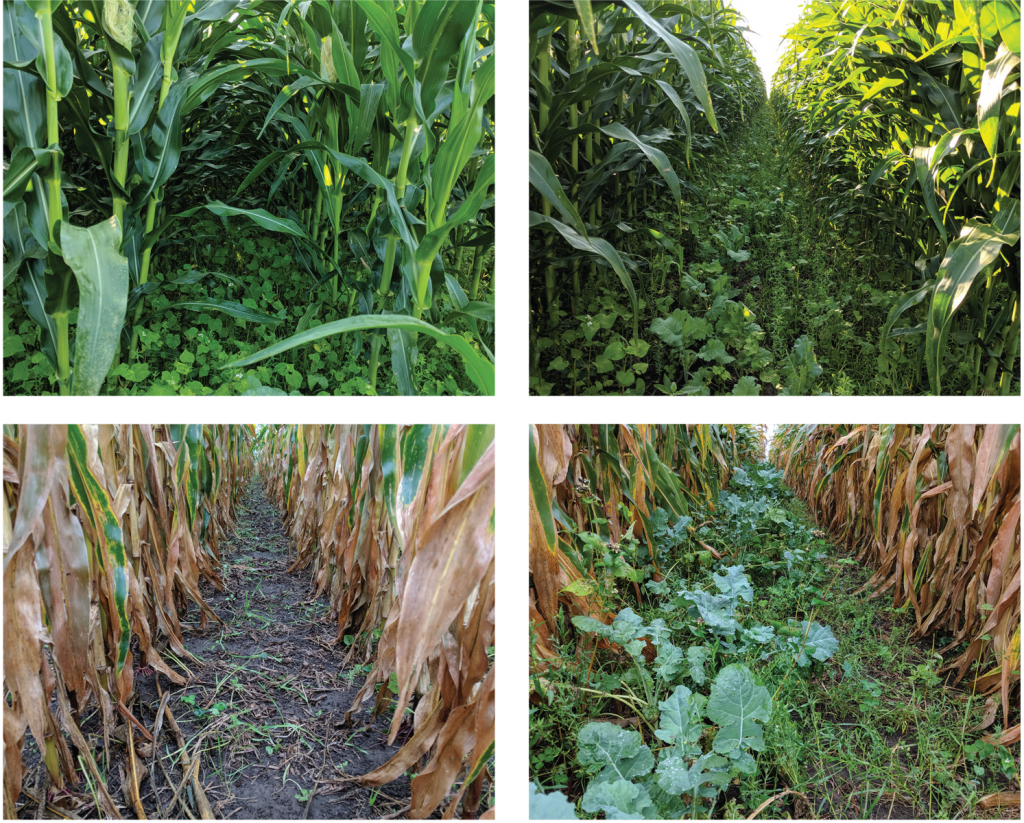
Cover crops interseeded to corn in 30-in. row-widths (left) and 60-in. row-widths (right) at Nathan Anderson’s on July 18 (top row) and Sept. 19 (bottom row).
Corn yields
Compared to corn planted in 30-in. row-widths, corn planted in 60-in. row-widths reduced grain yields at Abels’, Anderson’s and Gustafson’s by 5–16% (Figure 1A, 1C, 1E). Earlage yield at Yoder’s was reduced by 2,884 lb/ac in 60-in. row-widths (Figure 1F). On the contrary, corn grain yields at Alexander’s and Boyer’s were statistically equal between the two row-width treatments (Figure 1B, 1D).
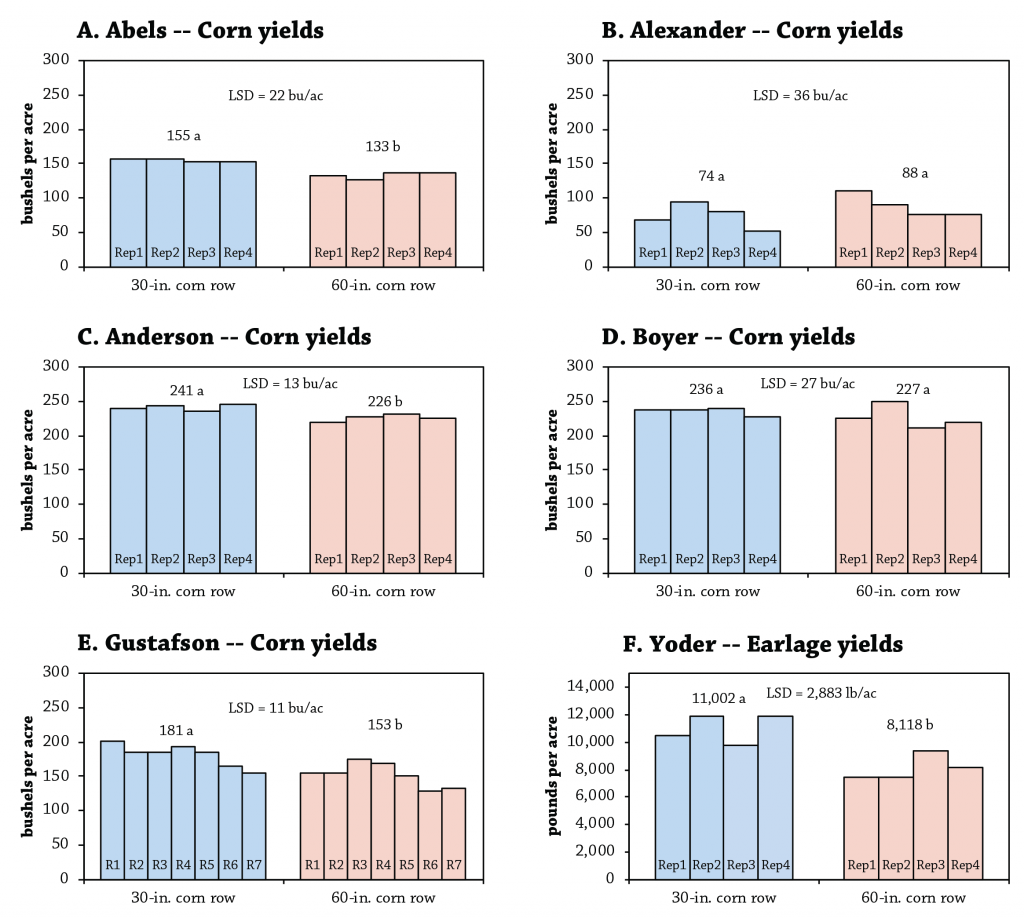
Figure 1. Corn yields as affected by row-width at A) Abels’, B) Alexander’s, C) Anderson’s, D) Boyer’s, E) Gustafson’s and F) Yoder’s in 2019. Columns represent individual strip yields. Above each set of columns is the treatment mean. By farm, if the difference between the treatment means is greater than the least significant difference (LSD), the treatment means are followed by different letter-rankings and are considered statistically different at the 95% confidence level. Click to enlarge.
Corn grain yields at Abels’, Alexander’s and Gustafson’s were below their respective five-year county averages of 205, 201 and 194 bu/ac.[4] Alexander attributed his low yields to severe cutworm damage in that field; he noted that other fields on his farm yielded better by 100 bu/ac. At Anderson’s and Boyer’s, corn grain yields were greater than their respective five-year county averages of 206 and 205 bu/ac.[4]
These mixed results mirror on-farm findings from 2018[2] as well as research conducted at the University of Missouri in 2005, 2006 and 2011. In the Missouri trials, corn planted in 60-in. row-widths achieved equivalent yields to corn in 30-in. row-widths in only 2005.[3] In 2006 and 2011, corn in 60-in. row-widths yielded 14–39% less than in 30-in. row-widths.
Conclusions and Next Steps
After two years of on-farm research, planting corn in 60-in. row-widths has resulted in statistically equal grain yields to corn planted in 30-in. row-widths in four of the 10 trials. In the six other trials, corn yields were reduced by 5–30% when planted in 60-in. row-widths. Cover crops interseeded to corn in 60-in. row-widths produced far more biomass in five of the seven trials that sampled over the two years. This represents the major appeal to planting corn in 60-in. row-widths: More cover crop biomass presents opportunities for more livestock grazing in the fall. Boyer, Abels and Alexander, however, each cited weed control as a challenge to this system. Lest risking injury to the cover crops, herbicides or interrow cultivation cannot be employed after the cover crops are interseeded to the corn (either row-width). As such, navigating the challenges and benefits of planting corn in 60-in. row-widths and interseeding with cover crops will be necessary before broader adoption of this practice.
“I wanted to see if I could maintain crop yields in 60-in. row-widths relative to 30-in. row-widths while growing cover crop biomass significant enough to have some grazing value,” Nathan Anderson said, who saw reduced corn yields in 60-in. row-widths (Figure 1C). “I will likely consider interseeding into corn earlier in the year to improve establishment success. I will also look at using more flex ear corn hybrids, at a lower population, to possibly improve corn yields as well as interseeding success.”
Appendix – Trial Design and Weather Conditions

Figure A1. Sample experimental design used by the cooperators. The design includes at least four replications of the two corn row-width treatments (8 strips total). This design allowed for statistical analysis of the results. Click to enlarge.
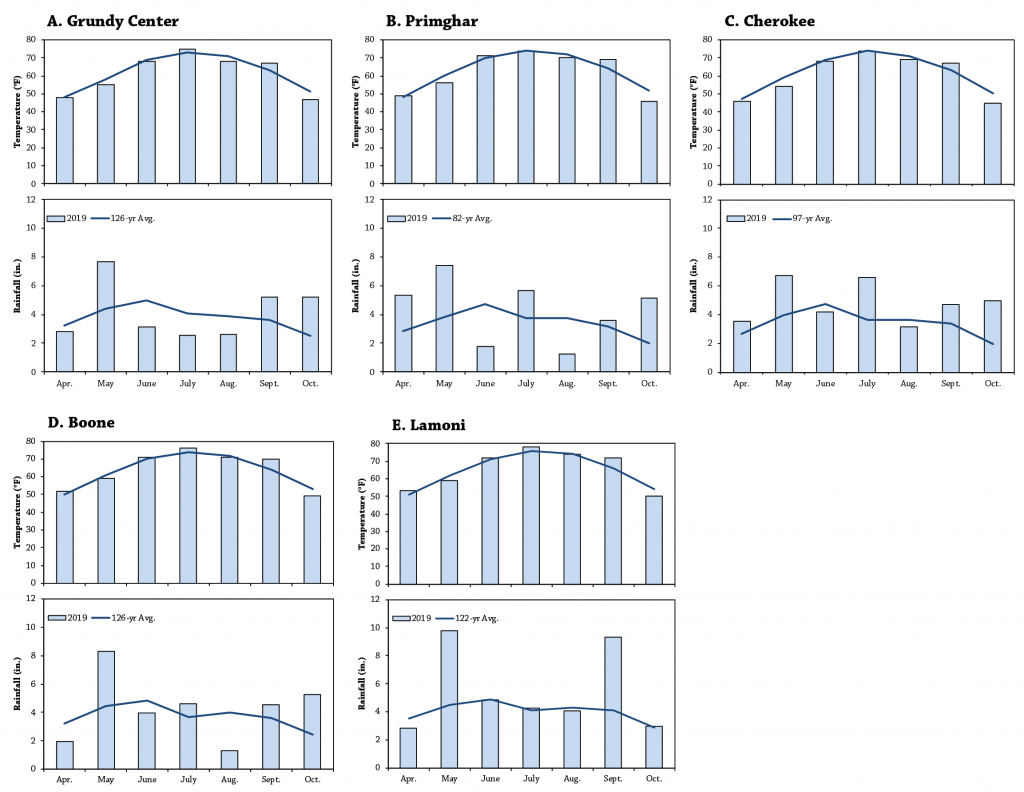
Figure A2. Mean monthly temperature and rainfall for 2019 and the long-term averages at the nearest weather stations to each farm.[5] A) Grundy Center (Abels, about 4 miles away; Boyer, about 9 miles away); B) Primghar (Alexander, about 15 miles away); C) Cherokee (Anderson, about 8 miles away); D) Boone (Gustafson, about 4 miles away); E) Lamoni (Yoder, about 20 miles away). Click to enlarge.
Funding Acknowledgement
This material is based upon work supported by the Natural Resources Conservation Service, U.S. Department of Agriculture, under number 68-6114-17-010. Any opinions, findings, conclusions, or recommendations expressed in this publication are those of the author(s) and do not necessarily reflect the views of the U.S. Department of Agriculture.
References
- Kremer, R.J. and C. LeRoy Deichman. 2014. Soil quality and the solar corridor crop system. Agronomy Journal. 106:1853–1858. https://www.researchgate.net/profile/Robert_Kremer/publication/266141259_
Soil_Quality_and_the_Solar_Corridor_Crop_System/links/5426cfc10cf26120b7b3449b/Soil-Quality-and-the-Solar-Corridor-Crop-System.pdf (accessed December 2019). - Gailans, S., J. Boyer, F. Abels, C. Teachout, B. Kessel, H. Kessel and J. Johnson. 2018. Planting Corn in 60-in. Row-Widths for Interseeding Cover Crops. Practical Farmers of Iowa Cooperators’ Program. https://practicalfarmers.org/research/planting-corn-in-60-in-row-widths-for-interseeding-cover-crops/ (accessed December 2019).
- Nelson, K.A. 2014. Corn yield response to the solar corridor in upstate Missouri. Agronomy Journal. 106:1847–1852. https://dl.sciencesocieties.org/publications/aj/abstracts/106/5/1847 (accessed December 2019).
- US Department of Agriculture-National Agricultural Statistics Service. Quick stats. USDA-National Agricultural Statistics Service. https://quickstats.nass.usda.gov/ (accessed December 2019).
- Iowa Environmental Mesonet. 2019. Climodat Reports. Iowa State University. http://mesonet.agron.iastate.edu/climodat/ (accessed December 2019).


